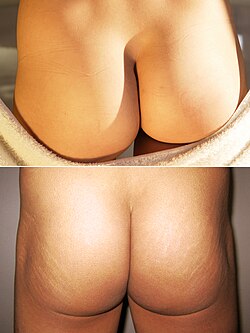| Buttocks | |
|---|---|
 Buttocks of a human female (upper) and a human male (lower) | |
| Details | |
| Artery | Superior gluteal artery, inferior gluteal artery |
| Nerve | Superior gluteal nerve, inferior gluteal nerve, superior cluneal nerves, medial cluneal nerves, inferior cluneal nerves |
| Identifiers | |
| Latin | clunis |
| MeSH | D002081 |
| TA98 | A01.1.00.033 A01.2.08.002 |
| TA2 | 157 |
| FMA | 76446 |
| Anatomical terminology | |
The buttocks (sg.: buttock) are two rounded portions of the exterior anatomy of most mammals, located on the posterior of the pelvic region. In humans, the buttocks are located between the lower back and the perineum. They are composed of a layer of exterior skin and underlying subcutaneous fat superimposed on a left and right gluteus maximus and gluteus medius muscles. The two gluteus maximus muscles are the largest muscles in the human body. They are responsible for movements such as straightening the body into the upright (standing) posture when it is bent at the waist; maintaining the body in the upright posture by keeping the hip joints extended; and propelling the body forward via further leg (hip) extension when walking or running.[1]
In many cultures, the buttocks play a role in sexual attraction.[2] Many cultures have also used the buttocks as a primary target for corporal punishment,[3] as the buttocks' layer of subcutaneous fat offers protection against injury while still allowing for the infliction of pain.
- ^ Norman Eizenberg et al., General Anatomy: Principles and Applications (2008), p. 17.
- ^ Hennig, Jean-Luc (1995). The rear view: A brief and elegant history of bottoms through the ages. London: Souvenir. ISBN 0-285-63303-1.
- ^ "Police". The Times. London. 22 March 1894. Archived from the original on 1 July 2014. Retrieved 5 December 2010.
Mr. Curtis Bennett deprecated caning on the hands and boxing the ears, and said they were exceedingly dangerous forms of punishment. Nature provided a special place for boys to be punished upon and it should be used.